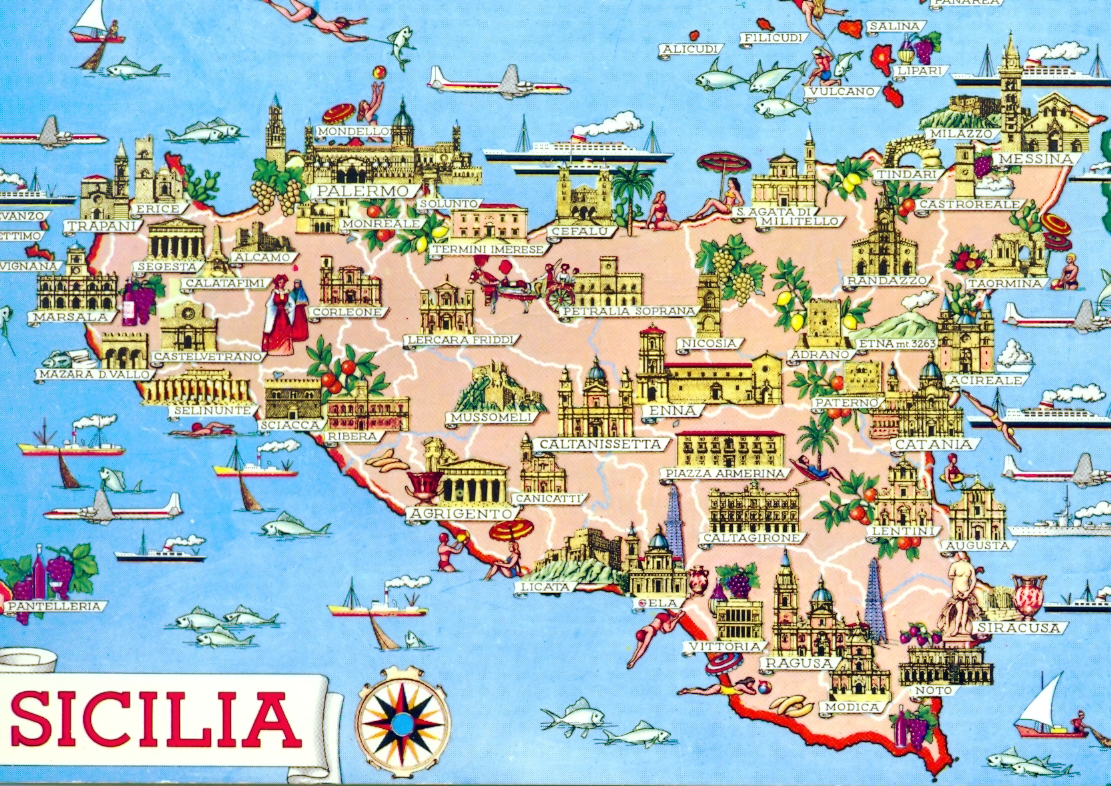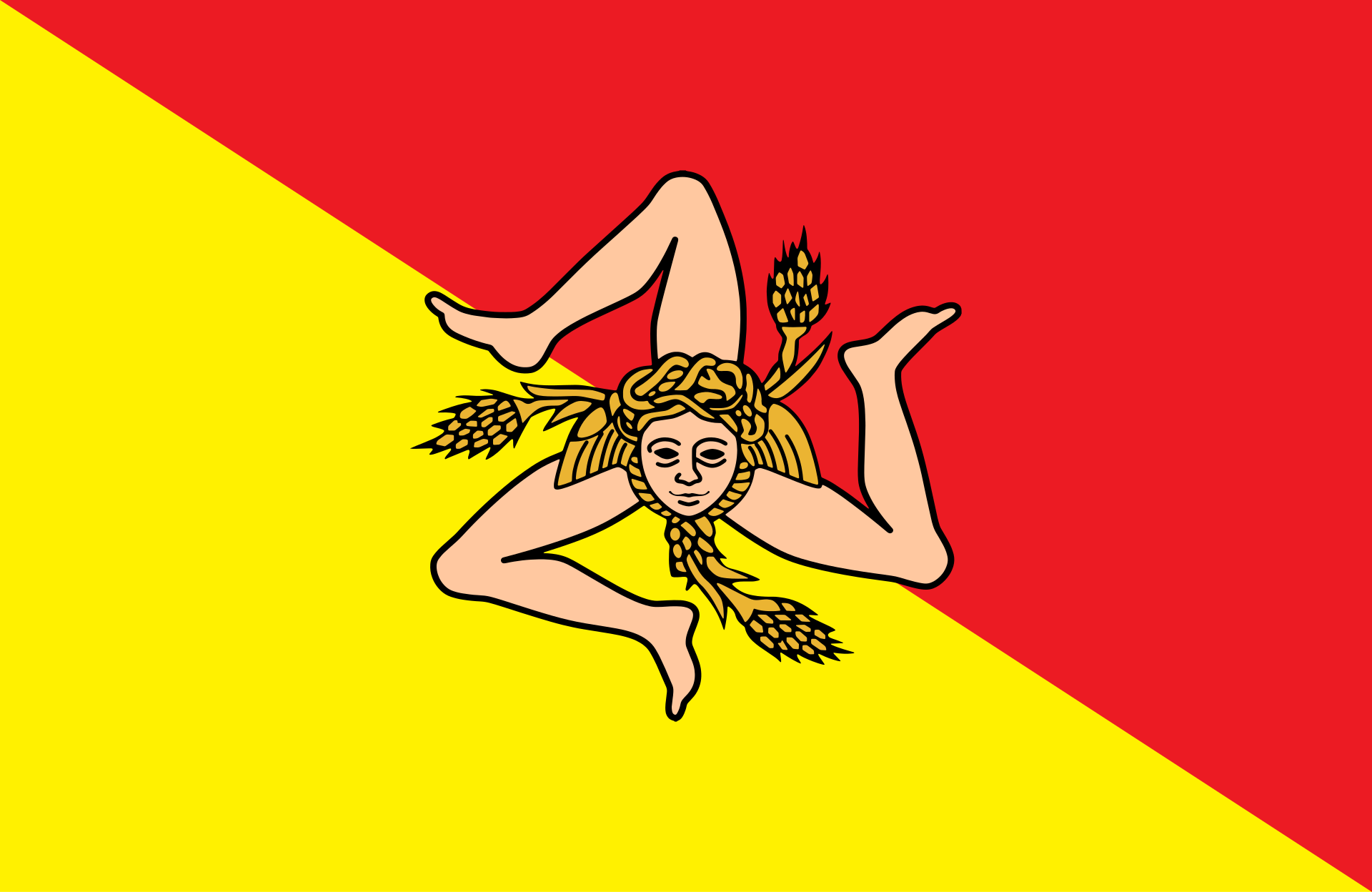
西西里(意大利语:Sicilia [siˈtʃiːlja])是意大利南部的一个自治区。西西里占地25,708平方公里,人口数为500万,是意大利最大的区。同时也是地中海最大的岛。而西西里岛周边几个中小型的岛屿也被纳入西西里区域范围。
在古中国称之为斯伽里野,《诸蕃志》:“斯加里野国,近芦眉国界,海屿阔一千里,衣服、风俗、语音与芦眉同。本国有山穴至深,四季出火,远望则朝烟暮火,近观则火势烈甚,国人相与杠舁大石,重五百斤或一千斤抛掷穴中,须臾爆出,碎如浮石。”[4]
明朝万历年间意大利传教士利玛窦参与绘制的《坤舆万国全图》称西西里岛为西齐里亚,并附注:“此岛有二山,一常出大火,一常出烟,昼夜不绝。”
由于西西里岛在地中海商业贸易路线中占据重要地位,因此在历史上一直被认为是一个具备重要战略意义的地方[5],北大西洋公约组织(NATO)在此设有美国海军和意大利空军共用的大型军用机场。西西里区域属于大希腊(古希腊殖民区)。而西塞罗曾经称锡拉库萨为古希腊中最美丽的城市。
西西里岛以及其周围属意大利岛屿一起组成西西里地区人口5,029,683人。其首府是巴勒莫(130万人口)。其它重要城市有卡塔尼亚(40万人口)、墨西拿(27万人口)、锡拉库萨(11万人口)、特拉帕尼(10万人口)、卡尔塔尼塞塔(8万人口)、阿格里真托(6万人口)和拉古萨(6万人口)等。西西里岛隔墨西拿海峡与亚平宁半岛相望。
西西里岛最高的山是埃特纳火山(3,323米),它也是欧洲最大、最活跃的火山。墨西拿北部的斯特龙博利岛上的斯特龙博利火山也是一座活火山。
Sizilien (italienisch und sizilianisch von gleichlautend lateinisch Sicilia aus altgriechisch Σικελίη Sikelíē oder – je nach Dialekt – Σικελία Sikelía, ältere Bezeichnungen zuvor Τρινακρία Trinakría[1], wörtlich „Dreikap“, und Σικανία Sikanía;[2] arabisch صقلية Siqilliyya[3]) ist mit 25.426 km² die größte Insel im Mittelmeer. Die Küstenlänge beträgt 1152 Kilometer.[4] Gemeinsam mit einigen ihr vorgelagerten kleineren Inseln bildet sie die Autonome Region Sizilien der Italienischen Republik.
Der aus Sizilien stammende Historiker Diodor schrieb: „Als über die erste Insel werden wir über Sizilien sprechen, weil sie die bedeutendste ist und wegen des Alters der über sie erzählten Geschichten die erste Stelle einimmt.“[5]
Die Insel Sizilien liegt südwestlich vor der „Stiefelspitze“ Italiens und ist der Überrest einer Landbrücke, die einst Europa und Afrika verband. Das geographisch markanteste Merkmal der Insel ist der Vulkan Ätna. Die größten Städte sind Palermo – die Hauptstadt der Autonomen Region, Catania, Messina und Syrakus.
シチリア島(イタリア語: Sicilia [siˈtʃiːlja], シチリア語: Sicìlia)は、イタリア半島の西南の地中海に位置するイタリア領の島。地中海最大の島である。
周辺の島を含めてシチリア自治州を構成している。この州はイタリアに5つある特別自治州のひとつである。州都はパレルモ。
Sicily (Italian: Sicilia [siˈtʃiːlja]; Sicilian: Sicìlia) is the largest island in the Mediterranean Sea. It is an autonomous region of Italy, in Southern Italy along with surrounding minor islands, officially referred to as Regione Siciliana.
Sicily is located in the central Mediterranean Sea, south of the Italian Peninsula, from which it is separated by the narrow Strait of Messina. Its most prominent landmark is Mount Etna, the tallest active volcano in Europe,[4] and one of the most active in the world, currently 3,329 m (10,922 ft) high. The island has a typical Mediterranean climate.
The earliest archaeological evidence of human activity on the island dates from as early as 12,000 BC.[5][6] By around 750 BC, Sicily had three Phoenician and a dozen Greek colonies and, for the next 600 years, it was the site of the Sicilian Wars and the Punic Wars. After the fall of the Roman Empire in the 5th century AD, Sicily was ruled during the Early Middle Ages by the Vandals, the Ostrogoths, the Byzantine Empire, and the Emirate of Sicily. The Norman conquest of southern Italy led to the creation of the Kingdom of Sicily, which was subsequently ruled by the Hohenstaufen, the Capetian House of Anjou, Spain, and the House of Habsburg.[7] It was finally unified under the House of Bourbon with the Kingdom of Naples as the Kingdom of the Two Sicilies. It became part of Italy in 1860 following the Expedition of the Thousand, a revolt led by Giuseppe Garibaldi during the Italian unification, and a plebiscite. Sicily was given special status as an autonomous region on 15th May 1946, 18 days before the Italian constitutional referendum of 1946. Albeit, much of the autonomy still remains unapplied, especially financial autonomy, because the autonomy-activating laws have been deferred to be approved by the parithetic committee (50% Italian State, 50% Regione Siciliana), since 1946.
Sicily has a rich and unique culture, especially with regard to the arts, music, literature, cuisine, and architecture. It is also home to important archaeological and ancient sites, such as the Necropolis of Pantalica, the Valley of the Temples, Erice and Selinunte.
La Sicile (Sicilia /siˈtʃiːlja/ en italien et en sicilien) est une région autonome d'Italie. L'île homonyme, qui compose cette région à 98 %, est la plus grande île de la mer Méditerranée. Son chef-lieu est Palerme. La langue officielle est l'italien, mais elle a sa propre langue parlée et écrite. C'est la région la plus étendue de l'Italie et son territoire est constitué de neuf anciennes provinces à leur tour partagées en 390 municipalités. Elle est également la seule région italienne à compter deux des dix villes les plus peuplées du pays : Palerme et Catane. Le drapeau de la Sicile, la gorgone à trois jambes (Trinacria), représente les trois pointes de l'île, pointe ouest de Trapani-Marsala, pointe nord-est de Messine et pointe sud-est de Syracuse.
La Sicilia (AFI: /siˈʧilja/[14]; Sicìlia in siciliano[15], Səcəlia in gallo-italico, Siçillja in arbëresh[16], Σικελία in greco), ufficialmente denominata Regione Siciliana, è una regione autonoma a statuto speciale di 5 017 216 abitanti[3], con capoluogo Palermo.
Il territorio della regione è costituito quasi interamente dall'isola omonima, la più grande isola dell'Italia e del Mediterraneo, nonché la 45ª isola più estesa nel mondo. La parte rimanente è costituita dagli arcipelaghi delle Eolie, delle Egadi e delle Pelagie e dalle isole di Ustica e Pantelleria. È la regione più estesa d'Italia[17] e il suo territorio è ripartito in 390 comuni a loro volta costituiti in tre città metropolitane (Palermo, Catania e Messina) e sei liberi Consorzi comunali. È la quarta regione per popolazione (dopo Lombardia, Lazio e Campania). È bagnata a nord dal Mar Tirreno, a ovest dal Canale di Sicilia, a sud dal Mar di Sicilia, a est dal Mar Ionio e a nord-est dallo stretto di Messina che la separa dalla Calabria.
Le più antiche tracce umane nell'isola risalgono al 12.000 a.C. circa. In era protostorica fiorirono culture dette di Thapsos, di Castelluccio, di Stentinello. Popoli provenienti dal continente vi s'insediarono successivamente: tra essi i Sicani, i Siculi e gli Elimi. L'VIII secolo a.C. vide la Sicilia colonizzata dai Fenici e soprattutto dai Greci e nei successivi 600 anni divenire campo di battaglia delle guerre greco-puniche e romano-puniche. L'isola venne così assoggettata dai Romani e fu parte dell'impero fino alla sua caduta nel V secolo d.C..
Fu quindi terra di conquista e, durante l'Alto Medioevo, conquistata da Vandali, dagli Ostrogoti, dai Bizantini, dagli Arabi e dai Normanni con questi ultimi che fondarono il Regno di Sicilia. I Normanni furono l'unico popolo nordico (germani settentrionali) a conquistare e fondare uno stato nordico in Europa meridionale, il Regno di Sicilia, che durò dal 1130 al 1816; fu conquistato dagli Angioini e con la rivolta del vespro passò agli Aragonesi. L'isola poi divenne un vicereame di Spagna, passò brevemente ai Savoia e all'Austria e, infine, nel XVIII secolo, ai Borbone, sotto i quali, unito il regno di Sicilia al regno di Napoli, sorse nel 1816 il Regno delle Due Sicilie. La Sicilia fu unita allo Stato italiano nel 1860 con un plebiscito[18], in seguito alla spedizione dei Mille guidata da Giuseppe Garibaldi durante il Risorgimento. A partire dal 1946 la Sicilia, è divenuta regione autonoma, e dal 1947 ha nuovamente un proprio parlamento, l'Assemblea regionale siciliana o ARS, istituita ancor prima della nascita della Repubblica italiana.
Sicilia es una de las veinte regiones que conforman la República Italiana. Su capital y ciudad más poblada es Palermo. Está ubicada en Italia insular, limitando al norte con el mar Tirreno, al este con el estrecho de Mesina que la separa de Calabria, al sureste con el mar Jónico y al sur y oeste con el mar Mediterráneo. Con 5 088 889 habs. en 2013 es la cuarta región más poblada del país —por detrás de Lombardía, Lacio y Campania— y con 25 711 km², la más extensa. Es una de las cinco regiones con estatuto especial.
Es la séptima mayor isla europea por dimensiones. Se trata de la principal isla italiana y la mayor del mar Mediterráneo. Pero además, se encuentran varias islas más pequeñas: los archipiélagos de las Islas Eolias al nordeste, las Islas Egadas al oeste, las Islas Pelagias al suroeste, y las islas de Pantelaria al sur y Ustica al noroeste.1
Es la isla más densamente poblada del Mediterráneo, después de Malta, y la única región italiana que cuenta con dos ciudades entre las diez más pobladas del país: Palermo, quinta, y Catania, décima. Sicilia es considerada como un importante destino turístico de Europa, cuyos orígenes pueden retrotraerse al siglo XVIII, cuando la popularización que le supuso el Viaje a Italia de Goethe la convirtió en una etapa obligada del Grand Tour, el viaje educativo y de ocio que los jóvenes aristócratas europeos, en buena parte británicos, realizaban como culminación de sus estudios antes de ingresar en la edad adulta.
Сици́лия (итал. и сиц. Sicilia [siˈtʃiːlja]) — административная область в Италии площадью 25 711 км² и населением 4 999 932 человека (2013). Включает в себя одноимённый остров, а также прилегающие к нему острова Липарские, Эгадские, Пантеллерия, Устика и Пелагские.
На протяжении большей части своей истории Сицилия имела важное стратегическое значение благодаря выгодному расположению на средиземноморских торговых путях. Остров также известен как часть «Великой Греции». Цицерон описывал Сиракузы как самый большой и самый красивый город Древней Греции. Население острова в I тыс. н. э. превышало 2 млн человек, что делало Сицилию самым плотнонаселённым регионом планеты.




 Sicilia
Sicilia



